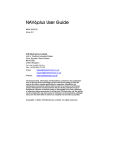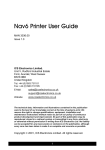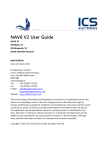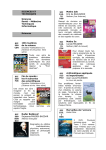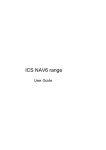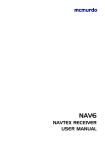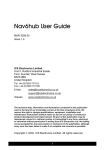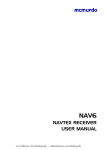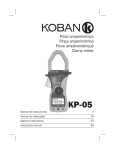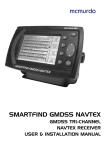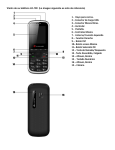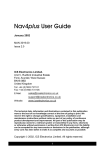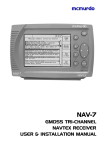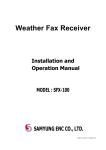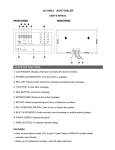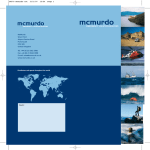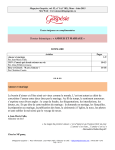Download NAV6 User Guide Issue 3
Transcript
NAV6 Series User Guide NAV6 NAV6plus NAV6repeater MAN 3030.00 Issue 3.0, March 2012. ICS Electronics Limited. Unit V, Rudford Industrial Estate Ford, Arundel, West Sussex BN18 0BF United Kingdom Tel: +44 (0)1903 731101 Fax: +44 (0)1903 731105 E-Mail: Website: [email protected] [email protected] www.icselectronics.co.uk The technical data, information and illustrations contained in this publication were to the best of our knowledge correct at the time of going to print. We reserve the right to change specifications, equipment, installation and maintenance instructions without notice as part of our policy of continuous product development and improvement. No part of this publication may be reproduced, stored in a retrieval system or transmitted in any form, electronic or otherwise without permission in writing from ICS Electronics Ltd. No liability can be accepted for any inaccuracies or omissions in the publication, although every care has been taken to make it as complete and accurate as possible. Copyright 2012, ICS Electronics Limited. All rights reserved. NAV6 Series NAVTEX System User Guide Important Information This equipment is not approved for use by SOLAS convention vessels within the Global Maritime Distress and Safety System (GMDSS) It is intended for use by leisure craft and other non-SOLAS vessels wishing to participate within GMDSS Safety Warnings This instrument is for use as an aid to sailors and should not lead to a reduction in the level of good seamanship required at all times Reception of messages cannot always be guaranteed as this depends on local radio propagation The correct magnetic variation must be input at the navigation instruments (e.g. GPS, electronic compass) for the accurate display of COG, set, waypoint bearing and heading. 2 NAV6 Series NAVTEX System User Guide Contents Introduction .............................................................................................. 5 NAV6 s Features ..................................................................................... 6 Basic Operation ....................................................................................... 8 Advanced Operation .............................................................................. 15 Navtex Mode .......................................................................................... 15 Navigate Mode – NAV6plus or NAV6repeater only ............................... 20 Setup Mode............................................................................................ 25 Alarm Operation ..................................................................................... 38 Printing NAVTEX And Navigation Log ................................................... 39 Output To A PC or Plotter ...................................................................... 40 Installation Of Display Unit ..................................................................... 41 Installation Of Receiver Unit .................................................................. 42 Connecting the Display Unit to the Receiver Unit.................................. 43 Connecting an antenna to the Receiver Unit ......................................... 45 Replacing an existing NAV6 installation ................................................ 54 Testing The NAV6 After Installation....................................................... 56 Maintenance and TroubleShooting ........................................................ 57 Warranty ................................................................................................ 59 Glossary ................................................................................................. 59 OPTIONAL EXTRAS ............................................................................. 60 Appendix I: Navtex Station Database .................................................... 64 Appendix II: Message Type Indicators .................................................. 75 Appendix III: NMEA Sentences Supported ............................................ 75 Appendix IV: NAV6 Menu Navigation .................................................... 76 Appendix V: NAV6 Menu Structure ....................................................... 77 3 NAV6 Series NAVTEX System User Guide NAV6 Complete System Showing Head Unit, NAVTEX Receiver Box and Passive Antenna Congratulations on purchasing this high quality ICS Electronics Ltd product. It is not only an excellent NAVTEX receiver, but a first class instrument repeater (Plus & Repeater models only). It may be the only display you will ever need at your navigation position. We hope that it gives you many years of reliable and trustworthy service. Please take the time to read this manual carefully as it contains some essential information regarding the operation and maintenance of the product and a useful background to the NAVTEX system. We recommend that you regularly visit the ICS website www.icselectronics.co.uk for information on updates, the availability of software enhancements, further options and support. The support pages contain frequently asked questions about the NAV6 that you may find useful. There is also a NAVTEX database providing a list of operational NAVTEX stations and their details. The IMO and various national coastguards also operate informative websites that you may wish to visit; see www.icselectronics.co.uk/links. Please note that the NAV6 standard model does not include the instrument repeater functions as described in this manual. It may be upgraded at anytime in the future (charges apply). 4 NAV6 Series NAVTEX System User Guide Quick Start You will find this product extremely easy to operate. Please don't be intimidated by the comprehensive nature of this manual. In reality, receiving your first NAVTEX messages just could not be simpler. • Follow the installation guidelines • Re-check the cable connections • Apply power • If you have not connected a GPS navigation receiver, make sure that you set the date and time on the screen which will appear at start up • Wait for your first NAVTEX message. If you are within range of a NAVTEX transmitter, you should not need to wait for more than four hours. • Refer to “Appendix IV : NAV6 Menu Navigation” for an overview of the available operating modes & how to switch between them. • Read the “Basic Operation” section to find out how to use some of the commonly used features of this product • If you then want to get the best from the system, read the rest of the manual! Introduction What Is NAVTEX? NAVTEX is a worldwide system for the broadcast and automatic reception of maritime safety information (MSI) in English by means of a narrow-band direct-printing telegraphy. NAVTEX provides shipping with navigational and meteorological warnings and urgent information. NAVTEX is a component of the IMO/IHO worldwide Navigational Warning Service (WWNWS) as defined by IMO Assembly resolution A.706(17). It is included within the Global Maritime Distress and Safety System (GMDSS). Since 1 August 1993, NAVTEX receiving capability has become mandatory equipment for certain vessels under the provisions of the International Convention for the Safety of Life at Sea (SOLAS). NAVTEX broadcast information is available to all seafarers, free of charge. 5 NAV6 Series NAVTEX System User Guide How Does NAVTEX Work? NAVTEX transmissions are sent from stations situated worldwide. The power of each transmission is regulated so as to avoid the possibility of interference between transmitters. Each station is allocated a 10-minute time slot every 4 hours so that many stations can share the same frequency. Stations typically have a transmission range of 250 – 300 Nm. NAV6 s Features The NAV6 adds a new dimension in NAVTEX functionality. Unlike other NAVTEX receivers that discard unselected messages, the large flash memory in the NAV6 means it has the capacity to store all of the messages from transmitting stations within its range. This allows you to recall, display and review any message at any time even if it was not selected at the time of the transmission. The NAV6plus offers simultaneous reception on both the 518kHz international channel and the 490kHz local information channel and when connected to an NMEA data source, it offers a range of standard and custom instrument repeater functions. The NAV6plus includes a database of all NAVTEX stations around the world and when connected to a GPS can be set to automatically display messages from all stations within range or just the closest station helping to provide a much clearer picture of the conditions in your area. A unique message processing (iNEC) feature benefits you by decreasing errors in received messages in noisy or weak signal areas. Choose from the NAV6 or NAV6plus according to your requirements and budget. Outputs are also included for connection to a serial printer or computer. The NAV6plus and NAV6repeaterinclude additional instrument repeater functions. All the information you really need at your navigation position on one large, easy to use display. With navigation space becoming more and more restricted in modern boats, the NAV6plus concentrates all the data you need, where you need it. It takes critical NMEA data from your GPS or instrument systems and displays it in a highly innovative manner. An electronic log book is updated at regular intervals and can be sent to a serial printer. These powerful Instrument and GPS repeater functions are included as standard in the NAV6plus. 6 NAV6 Series NAVTEX System User Guide The NAV6repeater can also be purchased separately without a NAVTEX receiver for use as a stand-alone NMEA repeater. When added to an existing system, NMEA data and NAVTEX data can also be repeated at another position such as the helm or fly bridge. Display Unit • The Display Unit uses a high resolution backlit LCD to display NAVTEX messages in a choice of text sizes. • The display unit contains a large non-volatile memory to store NAVTEX messages, NAVTEX station database, all of the user settings, filter options, LCD contrast and backlight levels. All messages and settings are retained during power down. • Several messages can be displayed at once (depending upon the length of the message) and messages can be scrolled with a single keypress. • Messages can be filtered and sorted using a number of user selectable criteria. • The NAV6plus and NAV6repeater can act as an NMEA instrument repeater and is capable of displaying data in a choice of formats. • The NAV6plus and NAV6repeater can be connected to a printer or computer to print NAVTEX messages and Navigation logs. • Audible and visible alarms can be set up to indicate reception of SAR and/or New Messages. • A sleep mode allows long standby periods with minimum power consumption, such as when the vessel is left in a marina with main batteries being trickle charged from the shore. Receiver Unit (NAV6 and NAV6plus systems only) • The Receiver Unit contains dual receivers that can receive on both 490kHz and 518kHz simultaneously. 7 NAV6 Series NAVTEX System User Guide Basic Operation The NAV6 is a flexible & powerful tool for receiving, storing & viewing NAVTEX messages. In order to assist you in getting the best from your NAV6, read this section which contains short cuts to the most common NAVTEX operations. Please read the rest of the manual for a comprehensive guide to the NAV6 Series of NAVTEX products. First, find your way around the keypad and the display: The Keypad softkeys FUNCTION PAGE VIEW MODE navigation pad • Centre keys are a ‘navigation pad’ ( UP DOWN LEFT RIGHT ). • Softkeys are situated on either side of the navigation pad. The current function is shown on the soft-key menu area at the bottom of the LCD. • The mode softkey switches between the three operating ‘modes’ (NAVTEX, Navigate & Setup). • The view softkey switches between ‘views’ in each operating ‘mode’. If a ‘view’ has several ‘pages’ associated with it then these are selected with the page softkey. • Operate the keys in this order to get to the mode that you want: MODE → VIEW → PAGE → FUNCTION 8 NAV6 Series NAVTEX System User Guide Hint : softkeys are context sensitive and cyclical in operation, several button presses will return you to the start of the cycle. The Display At the bottom of the display is the softkey menu area: Current option Current softkey function The softkey menu area shows what each softkey does in the current operating mode. • The top line of each softkey menu box indicates the option that is currently selected. The bottom line of each softkey menu box indicates the current function of that softkey. The example above shows the NAV6 in NAVTEX Mode; the right hand softkey selects the ‘mode’ & the current mode is ‘NAVTEX’. • 9 NAV6 Series NAVTEX System User Guide At the top of the display is a status bar: The status information is displayed as a series of icons. The meaning of the icons is as follows: Message ID for the upper most message An alarm is active NMEA / GPS position data available 490 kHz reception available 518 kHz reception available Receiving message now Signal Carrier, but no message Receiver Communication fault SAR message received NEW message received UTC Time 10 NAV6 Series NAVTEX System User Guide Viewing & Scrolling Through NAVTEX Messages To view NAVTEX messages you must first select the NAVTEX Mode. Use the right hand softkey to change modes until ‘NAVTEX Mode’ is visible in the right hand softkey menu box. You can now use the UP, DOWN, LEFT & RIGHT keys to scroll through the displayed messages. UP & DOWN scroll line by line, whereas LEFT & RIGHT scroll message by message. The messages currently displayed are a sub-set of all the messages stored in memory. Whether you can see a particular message or not depends upon the current station selection, message filter and age limit settings (see following sections for details). Message Storage All received NAVTEX messages are stored in memory regardless of whether you have them selected for viewing or not. The NAV6 has lots of memory so you will easily have enough storage for all messages received in any 72 hour period. The messages displayed are selected from the NAV6’ memory by applying the current message filter preset & age limit settings. This enables you to change your mind later about your message display options. This means you will still be able to view messages that were received previously, but were not selected for display at the time, by changing the current message filter or age setting. After using the NAV6 for a while you may notice that if you receive a particular message more than once there will only ever be one copy in view. If a message has been received more than once the NAV6 will store only the best version. It even attempts to repair corrupted messages by comparing repeated transmissions of the same message! Filter Presets The messages currently available for viewing on screen are selected from the messages stored in memory by applying ‘filter presets’. To see the current selected filter presets go to [NAVTEX Mode⇒ ⇒Filter View]. You will notice that the left hand softkey is labelled ‘Preset’ and a number from 1 to 5 is visible. This is the currently selected filter preset number for the this ‘filter page’. Each of the 4 filter pages (518 Types, 518 Stns, 490 Types & 490 Stns) has its own 5 presets. In any one of the filter pages press PRESET to change the preset 11 NAV6 Series NAVTEX System User Guide number. You will notice that the settings on the screen change with filter preset number. Select the preset that you require for the filter page that you are viewing and then look at the presets for the other filter pages. Note that the preset that is displayed is the one that is currently applied to the message display. Multiple presets can be used for switching quickly between different sets of messages on the screen. For instance, if you want to show just ‘navigational warnings from all stations in range’, you can use a preset to do this. Although the presets are pre-programmed, you can set them to any filter setting you require. Tip : Use preset 1 for normal operation and only use the other presets if you want to switch between different sets of messages on the display. Station Selection If you leave your NAV6 receiving for 72 hours you will have received many messages (subject to your current location) and unless you filter out those stations that are not required for display, you will be swamped with data. This can either be done automatically using a GPS or by using manual filter settings. In either case go to [NAVTEX Mode⇒ ⇒Filter View⇒ ⇒490 or 518 Stns Page]. You will notice that each station can be set to one of three filter settings: Setting On Off Auto Operation Messages from station always in view (see note 1) Messages from station never in view Messages from station only viewed when nearest or in range depending upon setting (see note 1) note 1 : messages are only displayed if they also fall within the ageing limit, error limit and message category filter settings. An asterisk to the right of the station name indicates that the station is selected with the current filter setting. Automatic Station Selection Using GPS (NAV6plus only) Many users will just want to display NAVTEX from the nearest NAVTEX station to their cruising location. This is most easily achieved by 12 NAV6 Series NAVTEX System User Guide connecting a GPS and selecting ‘Nearest’ station option in the set up page. With a GPS connected and ‘Nearest’ selected you should only see one (or sometimes two) asterisks. Ensure that the set of stations that you want to automatically select from are all set to Auto. Stations that you definitely do not want should be set to Off. You may wish to set your ‘home’ station to On so that you display messages from it even if it is currently not the nearest station to your cruising position. Manual Station Selection Alternatively, you can manually select a station (or stations) setting stations to On or Off by using the UP, DOWN, LEFT & RIGHT keys. If you are using a GPS but still want to select stations manually then do not leave any stations set to Auto. Message Filtering You can further reduce the amount of unwanted messages that are displayed by applying a filter to the message categories. Go to [NAVTEX Mode, Filter View, 490 or 518 Types Page]. Each message category can be turned On or Off or can be set to New using the UP, DOWN, LEFT & RIGHT keys. Reading ‘New’ Messages Sometimes it is useful to know which messages have been received since you last looked at the NAV6 display. You may have noticed that each message header carries a ‘NEW’ icon and that there is an additional ‘NEW’ icon in the status bar at the top of the display. Select [NAVTEX Mode⇒ ⇒Message View] and you will see that what was the PAGE softkey is now indicated as NEXT NEW. If the message at the top of the display has the ‘NEW’ icon showing then the left hand softkey will now be indicated as MARK READ. Once you have read the message & want to de-emphasise it then press MARK READ. The ‘NEW’ icon will disappear from the message header. Press NEXT NEW to jump to the next new message. Proceed through all of the messages in this way. Once all of the messages have been marked as read then the ‘NEW’ icon at the top of the display will also disappear. When you return to the NAV6plus later on it is now very easy to tell if there are any new messages to read (the ‘NEW’ icon in the status bar at the top of the 13 NAV6 Series NAVTEX System User Guide display will be illuminated). Note that messages that have been ‘marked as read’ will still be displayed, but with the ‘NEW’ icon removed from the header in each one. However, it is possible to hide messages once they have been read. Go to [NAVTEX Mode⇒ ⇒Filter View⇒ ⇒490 or 518 Types Page] and set the message categories that you want to hide after they have been marked as read to ‘New’ instead of ‘On’. You may wish to leave SAR messages as ‘On’ so that they are not hidden once read. Displaying The Newest Message All messages are date and time stamped by the NAV6 even if there is no GPS connected and therefore no correct source of time data. If there is not a GPS connected then you can manually enter the time and date or just ignore it. The NAV6 will still order the messages in the correct chronological order (remember that the indicated time of reception will be wrong though). To display the newest message, go to [NAVTEX Mode⇒ ⇒Sort View⇒ ⇒Descending Order⇒ ⇒Date Criteria]. The newest message is now at the top of the display. Message Aging NAVTEX messages become less relevant over time & eventually just clutter the display. In order to reduce the number of obsolete NAVTEX messages that are being displayed, the NAV6 uses the concept of a message ‘Age Limit’. It is possible to hide messages that are older than a certain pre-settable age limit. These messages are still stored in the NAV6plus memory for a considerable time after they have been removed from the display and can still be displayed if necessary by increasing the message age limit setting. To change the age limit go to [Setup Mode⇒ ⇒NAVTEX View⇒ ⇒Options Page] and select the age limit that you require. Use the UP & DOWN key to select ‘age limit’ and LEFT & RIGHT keys to select a value. 3 days is a sensible choice as NAVTEX messages have a nominal life of 72 hours. Set a longer age limit if you wish to display NAVTEX messages going back over the previous weeks. 14 NAV6 Series NAVTEX System User Guide Advanced Operation This section provides a detailed description of the operation of your NAV6. The three operating modes are described in detail. Remember to use the right-hand MODE softkey to switch between the operating modes. Navtex Mode NAVTEX Mode is only available if a receiver is (or has been) connected to the display and the NAVTEX frequency setting on the NAVTEX options page is set to 518 kHz, 490 kHz or Both. In NAVTEX Mode, the display consists of a large area dedicated to displaying NAVTEX messages, with a status bar at the top, and descriptions of the softkey functions at the bottom. It is possible to scroll up and down the messages line by line, using the UP and DOWN keys. Additionally, you can step through the display, message by message using the LEFT and RIGHT keys. Four different ‘views’ can be selected by pressing the VIEW softkey: Message View Print View (when enabled in setup) Sort View Filter View 15 NAV6 Series NAVTEX System User Guide NAVTEX Mode, Message View This view can be used for keeping track of new messages as they are received and displayed. Each new message can be accessed by a single key press & then marked as read, if required. The NEXT NEW softkey should be used to move the next new message to the top of the NAVTEX display, where it can be marked as read by pressing MARK READ. Note that the message that will be ‘marked as read’ is indicated in the top left of the status bar. This is particularly useful when the message’s header has scrolled off the top of the display area. NAVTEX Mode, Print View This view allows individual messages to be printed. The ‘Print View’ is only displayed if the manual print setting is enabled on the [Setup Mode⇒ ⇒NAVTEX View⇒ ⇒Options Page]. Printing is only possible if an external printer or PC is installed as part of the system. The NEXT NEW softkey can be used to move the next new message to the top of the NAVTEX display where pressing PRINT will print it. NAVTEX Mode, Sort View From within this view different sort criteria can be applied to order the messages on the display. The NAVTEX Mode display can be sorted in one of three ways by pressing the CRITERIA softkey: Sort by Station Sort by Type Sort by Date The sort can be further organised in ascending or descending order by pressing the ORDER softkey. Sort by Station orders the messages by NAVTEX frequency and the alphabetical order of their station letters. Sort by Type orders the messages in the alphabetical order of their message identifier letter. Sort by Date orders the messages by the date and time that they were first received. For sort by date to work properly, the correct time and date should be set using either time data from the NMEA input or if this is not available, time should be entered manually at start-up. 16 NAV6 Series NAVTEX System User Guide NAVTEX Mode, Filter View This view allows specific stations to be selected for display and the various message categories to be turned on or off. Use the filter view to select which message types from which stations you wish to see displayed on the NAVTEX display. (Tip: even if you have de-selected messages from a particular station and/or message type, the system will still receive and store those messages. You will be able to view those messages by re-selecting them in Filter View.). 5 different sets of filter settings can be programmed into the unit. Using the filter presets allows quick selection of 5 different filter settings. Once a preset is selected, the filter settings for that preset may be changed as required. The filter settings for the current selected preset will be applied when NAVTEX messages are next viewed. Press the PRESET softkey to select a preset. (Tip: Set up the 5 filter presets for the stations and message types that you use most. For example: Preset 1 - all message types from nearest station; Preset 2 - meteorological warnings from nearest station, Preset 3 - navigational warnings from nearest station; Preset 4 - new messages of all message types from nearest station; Preset 5 – new messages of all message types from stations in range) There is a ‘stations’ and ‘types’ filter page for each selected receive frequency. Use the PAGE softkey to select one of the four possible filter pages: 518 Stations, 518 Types, 490 Stations, or 490 Types. 17 NAV6 Series NAVTEX System User Guide Message Categories The picture shows the 518 Types filter page; the 490 Types filter page is similar. Each of the message types can be selected as either On, Off or New Use the UP and DOWN keys to select the message type setting that you wish to edit. Use the LEFT and RIGHT keys to change the setting. Set each message type filter to one of the following: Setting On Off New Notes Message type always displayed Message type never displayed Message type only displayed when new. Messages marked as read will not appear. 18 NAV6 Series NAVTEX System User Guide Stations The picture shows the 518 Stations filter page; the 490 Stations filter page is similar. Use the UP and DOWN keys to select the station filter setting that you wish to edit. Use the LEFT and RIGHT keys to change the setting. The ‘Auto Station Filter’ setting can be either Nearest or In Range. This setting is active only when you have a GPS receiver connected to the NMEA input and it applies only to stations set to Auto. To display messages from the nearest station to your current position, set the auto station filter to Nearest. To display messages from all stations in range of your current position, set the auto station filter to In Range. For all settings, an asterisk appears next to all stations for which messages will be displayed. Set the filter for each station to one of the following: Setting On Off Auto Notes Messages from station always displayed Messages from station never displayed Messages from station displayed only when nearest or in range depending upon ‘Auto Station Filter’ setting. Important (NAV6plus Only): You may wish to leave your NAV6plus running whilst your GPS or instrument system is disconnected or switched off. If you do this then please be aware that the Navigate data items derived from NMEA (including position) will time out after a short while. If you have also opted to display only the ‘nearest’ NAVTEX station or stations ‘in range’ then the NAV6plus will no longer have the required position data. It will revert to displaying all stations that are set to ‘Auto’. As soon as the NMEA data becomes available again only the ‘Nearest’ or ‘In Range’ stations will be displayed dependent upon your current settings. 19 NAV6 Series NAVTEX System User Guide Navigate Mode – NAV6plus NAV6plus or NAV6repeater NAV6repeater only Navigate Mode is only available if there is a GPS or other source of NMEA 0183 data connected to the NAV6 Receiver Unit NMEA input. The GPS icon in the status bar at the top of the display will be illuminated only if there is position data available on the NMEA input. There are five fixed-format Navigate data display views and four user configurable views. These can be selected from within the Navigate Mode using the VIEW softkey. The five fixed views are: Position View Combined View Waypoint View Conning View Log View The user configurable views are User Views 1,2,3 and 4. (Tip: Disable views that are not required, in [Setup Mode⇒Navigate ⇒Options Page and Setup Mode⇒Navigate⇒User View Page]. Display units can be changed in the Navigate Options page). Note: Data fields that are not available on the NMEA input are indicated by a series of dashes (e.g. ---.--). Important • The correct magnetic variation must be input at the navigation instruments (e.g. GPS, electronic compass) for the accurate display of COG, set, waypoint bearing and heading. • For the purposes of testing your installation, you may wish to use your GPS’s simulator mode to generate data for the NAV6plus. Please check your GPS User Manual to find out whether it transmits valid NMEA data whilst it is in its simulator mode – many GPS’s do not set the ‘data valid’ flag in the NMEA sentences during simulation. As a safety feature, the NAV6plus will ignore any NMEA sentences where the ‘data valid’ flag is not set. • The NAV6plus has a built in NMEA simulator mode – please ensure that it is switched OFF in normal operation. 20 NAV6 Series NAVTEX System User Guide Position View The Position View shows GPS information (Position, COG and SOG), Depth reading and Distance log using a large font. The UP, DOWN, LEFT and RIGHT keys have no function. Combined View The Combined View shows all NMEA input data on one screen using a small font. The UP, DOWN, LEFT and RIGHT keys have no function. 21 NAV6 Series NAVTEX System User Guide Waypoint View The Waypoint View shows waypoint navigation information and a graphical “rolling road” display of the boat position and course relative to the course line. The rolling road display can be used to steer the boat along the course line whilst keeping the cross track error within chosen limits (the XTE limit may be changed on the [Setup mode⇒ ⇒Navigate View⇒ ⇒Options Page] ). The Waypoint View shows the waypoint name, waypoint position, time to go (TTG in hours, minutes and seconds), range and bearing to waypoint, closing speed to way point, cross track error and COG and SOG. The UP, DOWN, LEFT and RIGHT keys have no function. Conning View The Conning Display is a unique analogue display which shows overlapping vectors for Heading (course through the water), Course Over the Ground (COG), Set (a combination of leeway and tide) and wind. All of these vectors are displayed relative to the current heading, which is displayed in digital form at the top of the screen. Heading is shown as a single headed arrow; Course Over the Ground (COG) is shown as a double headed arrow, and Set is shown as a triple headed arrow - in the familiar manner. The wind vector displays variable tail patterns according to the strength of 22 NAV6 Series NAVTEX System User Guide the wind. It follows the usual meteorological wind symbol rules: 5 kts per half feather, 10 kts per full feather, 50 kts per triangle. Computed Set and Drift and other related parameters are shown in digital form at the bottom of the screen. To take into account various sea states, variable damping levels may be selected by pressing the LEFT and RIGHT arrow keys. The currently selected level is shown in the top right hand corner of the display. The damping level can be None, Low, Medium or High. The damping level affects COG, SOG, Heading and Water Speed and Set and Drift readings. The UP and DOWN keys have no function. Log View The UP and DOWN keys allow the log to be scrolled forwards and backwards in time. The LEFT and RIGHT keys scroll other LOG data into view. (Tip: consider the Log View to be a large piece of paper. The LCD allowing a smaller view which can be moved up, down, left and right displaying a portion of the paper at any one time) The Log View columns are Position, COG, SOG, Heading, Water Speed, Wind Direction, Wind Speed, Depth and Distance. 23 NAV6 Series NAVTEX System User Guide User Views The four user views can be configured to show either 2, 3 or 4 panels (picture shows a 3 panel view). Each panel can be configured to show different navigation information from a range of options. See the [Setup Mode⇒ ⇒Navigate View⇒ ⇒User View Page] for more details of the available options. The UP, DOWN, LEFT and RIGHT keys have no function. 24 NAV6 Series NAVTEX System User Guide Setup Mode This mode enables the user to modify the operation of the NAV6. NAVTEX message display presentation, Navigate data presentation, LCD operation & printing operation can all be controlled from Setup Mode. Setup Mode consists of 3 ‘Views’ that can be selected with the VIEW softkey. Each View has a number of ‘Pages’ that can be selected with the PAGE softkey. General View LCD Page Options Page NAVTEX View Options Page 490 Names Page 518 Names Page Monitor Page Navigate View Options Page User View Page Monitor Page Setup Mode, General View, LCD Page The General View LCD Page shows a checker board pattern that can be used to set up the LCD. LCD contrast is adjusted with the LEFT and RIGHT keys. LCD brightness is adjusted with the UP and DOWN keys. There is a readout of the LCD backlight temperature towards the bottom of the display. This is internal case temperature, and gives only an approximation to ambient temperature. (Tip: If the LCD is unreadable due to incorrect contrast setting, hold down the MODE softkey for more than 2 seconds, in any operating mode, to display the LCD page and reset the LCD contrast and backlight to 50%. The LCD should now be readable. Adjust the contrast as required). 25 NAV6 Series NAVTEX System User Guide Setup Mode, General View, Options Page Option Year Month Day Hour Minute Keyclick New Message Alert Antenna Alarm SAR Alarm Language LED Function Setting YYYY MM DD HH mm OFF ON OFF ON OFF Timed Repeated OFF Timed Repeat English Francais Portugues Deutsch OFF ON RX SAR NEW Notes Year, e.g. 2001 Month, e.g. 03 Day, e.g. 15 24 hour clock Minutes No beep on key press Beep on key press New message alert off Audible alarm for new messages Antenna alarm off Antenna alarms repeated 5 times, unless cancelled Antenna alarms repeated until cancelled SAR alarm off SAR alarms repeated 5 times, unless cancelled SAR alarms repeated until cancelled English language menus French language menus Portuguese language menus German language menus LED always off LED as power indicator LED as receive indicator LED as SAR indicator LED as New Message indicator Defaults shown in BOLD 26 NAV6 Series NAVTEX System User Guide General View Options Page This view shows general settings for the display such as Date, Time, Sound and Miscellaneous settings. Use the UP and DOWN keys to select the setting that you wish to edit. Use the LEFT and RIGHT keys to change the setting. Notes: • Date and time will be taken from NMEA input data if available. • There is no battery backup so date and time will be incorrect when power is switched on unless NMEA data is available or the date and time are manually set. The date and time is used to mark all incoming NAVTEX messages so that they can be sorted by date and time. Setup Mode, NAVTEX View, Options Page The [Setup Mode⇒ ⇒NAVTEX View⇒ ⇒Options Page] shows general settings for NAVTEX operation such as Antenna, Display, Sound and Print settings. Use the UP and DOWN keys to select the setting that you wish to edit. Use the LEFT and RIGHT keys to change the setting. 27 NAV6 Series NAVTEX System User Guide Option Font Setting Small Medium Large Error Threshold XX % Alphabet Latin Cyrillic Age Limit NAVTEX Frequency None, 1, 2, 3, 5 Days, 1, 2, 3, 4, 8, 12 Weeks None 490 kHz 518 kHz Both New Message Alert Antenna Alarm SAR Alarm Display Mode Off On Off Timed Repeat Off Timed Repeat Master Slave Notes Display NAVTEX messages using small font Display NAVTEX messages using medium font Display NAVTEX messages using large font Percentage character error rate above which messages are not displayed. Note that this setting does not stop messages with an error rate above the threshold from being stored in memory Latin alphabet used for NAVTEX messages. Latin alphabet with third shift Cyrillic used for NAVTEX messages Maximum age of NAVTEX messages to be displayed. NAVTEX messages older than the age limit are not displayed No receiver selected. Tip: useful when using the display only as a NMEA instrument repeater 490 kHz only operation 518 kHz only operation 490 and 518 kHz operation – only available if antenna Type is ‘Dual’ New message alert off Audible alarm for new messages Antenna alarm off Antenna alarms repeated 5 times, unless cancelled Antenna alarms repeated until cancelled SAR alarm off SAR alarms repeated 5 times, unless cancelled SAR alarms repeated until cancelled Set to master if this is the main display. This display will control the receiver over the receiver data link. Only one display may be set to master. Set to slave if this is a repeater unit. Slave units do not control the receiver and can 28 NAV6 Series NAVTEX System User Guide Option Setting Auto Print Off On Manual Print Off On Output Format Data Printer Antenna Type Firmware Version Hardware Revision Switchable Dual X.X X Notes only monitor the receiver data link. There can be multiple slave displays in a system Auto printing off Auto printing on. New messages will be printed when received. The print filter settings can be used to filter which messages are printed based upon message type and station Manual printing off. The NAVTEX Mode, Print View is hidden Manual printing on. The NAVTEX Mode, Print View is enabled Formatted for PC. Messages printed in raw format as received. Formatted for printing. Messages printed with print header. Reported by receiver, cannot be changed Reported by receiver, cannot be changed Reported by receiver, cannot be changed Defaults shown in BOLD Setup Mode, NAVTEX View, Options Page, Print Setup – NAV6plus plus & NAV6repeater NAV6 NAV6repeater only Press the PRINT SETUP softkey from within the [Setup Mode⇒ ⇒NAVTEX View⇒ ⇒Options Page] to display the print filter setup pages. Press the EXIT softkey to leave the print filter setup. Note: The print filter setup pages are available only when Auto Print is enabled. Use the print filter setup pages to select which message types from which stations you wish to have automatically printed when received. The print filtering is independent of the filtering used for the display. It does not affect the storage of messages for display on the NAVTEX screens. There is a stations and types filter page for each selected receive frequency. Use the PAGE softkey to select one of the four possible filter 29 NAV6 Series NAVTEX System User Guide pages: 518 Stations, 518 Types, 490 Stations, or 490 Types. The picture shows the 490 Types filter page; the 518 Types filter page is similar. Each of the message types can be selected as either ON or OFF. Use the UP and DOWN keys to select the message type setting that you wish to edit. Use the LEFT and RIGHT keys to change the setting. The picture shows the 518 Stations filter page; the 490 Stations filter page is similar. Use the UP and DOWN keys to select the station filter setting that you wish to edit. Use the LEFT and RIGHT keys to change the setting. The ‘Auto Station Filter’ setting can be either Nearest or In Range. The setting is active only when you have a GPS receiver connected to the NMEA input and it applies only to stations set to Auto. To print messages from the nearest station to your current position, set the auto station filter to Nearest. To print messages from all stations in range of your current 30 NAV6 Series NAVTEX System User Guide position, set the auto station filter to In Range. An asterisk appears next to all stations for which messages will be printed. Set the filter for each station to one of the following: Setting On Off Auto Notes Messages from station always printed Messages from station never printed Messages from station printed only when nearest or in range depending upon setting. Setup Mode, NAVTEX View, 518 and 490 Names Pages The station names setup pages determine the names of stations displayed on station filter pages and in NAVTEX message headers. The picture shows the ‘518 Names’ page; the ‘490 Names’ page is similar. Use the UP and DOWN keys to select the setting that you wish to edit. Use the LEFT and RIGHT keys to change the setting. The Station Name Selection setting allows the user to select between ‘GPS’ and ‘Manual’ station selection. If ‘GPS’ is selected and there is valid position data on the NMEA input, the NAV6 will select the NAVTEX transmitting station name nearest to the boat’s current location for each station letter. If ‘Manual’ is selected, then the user can manually select the transmitting station name to be displayed for each station letter. (Tip : You may be sailing in Nav Area II and therefore will pick station names from Nav Area II. However it is important to realise that the corresponding station letter in the adjacent Nav Areas may be closer. For example, the ‘S’ station that you are receiving is the ‘S’ station in an adjacent Nav Area). 31 NAV6 Series NAVTEX System User Guide Setup Mode, NAVTEX View, 518 and 490 Names, Station Database Setup Press the STATION DATABASE softkey from within the [Setup Mode⇒ ⇒NAVTEX View⇒ ⇒518 or 490 Names Page] to display the station database setup page for 518 or 490 kHz. Press the EXIT softkey to leave the station database setup. The station database page is divided into two halves. The top half shows a scrolling list of all stations in the database. The bottom half shows details of the current station selected in the station list. To edit an existing station entry: Use the UP and DOWN keys to select the station you wish to edit. Use the LEFT and RIGHT keys to jump to the next or previous station letter in the database. Press the EDIT softkey to edit the station details at the bottom of the display. The database entry for a typical station (i.e. ‘Niton’) is shown right. Data items are selected using UP and DOWN keys. Data items are changed using LEFT and RIGHT keys. When editing the station name, use the LEFT and RIGHT keys to change the letters. Use the NEXT softkey to accept the current letter and move the cursor to the right. Use the BACKSPACE softkey to delete the current letter and move the cursor to the left. 32 NAV6 Series NAVTEX System User Guide When editing the latitude and longitude fields, use the NEXT softkey to select the Degrees, Minutes or Cardinal part of the position. Use the LEFT and RIGHT keys to change the selected item. When you have finished entering the data, press the SAVE softkey to save and update the database or CANCEL softkey to abort the change. Field Station Area Name Latitude Longitude Range Operational Notes The station letter: A to X The Nav-Area: I to XVI The station name as displayed on NAVTEX messages. Up to 17 characters. The transmitter position. Used to determine the nearest and in-range stations The stated coverage range of the station in NM. Used to determine in range stations. Set to YES when the station becomes operational. Set to NO when the station is declared but not yet operational. When set to NO, the station will be excluded when determining the nearest and in range stations. To enter a new station: Press the NEW softkey to create a new database entry. The rules for entering a new station are identical to those described above for editing an existing station. When you have finished entering the data, press the SAVE or CANCEL softkey as required. To delete a station : Use the UP, DOWN, LEFT and RIGHT keys to select the station in the station list that you wish to delete. Press the DELETE softkey. Confirm or cancel the deletion by pressing the CONFIRM or CANCEL softkeys. 33 NAV6 Series NAVTEX System User Guide Setup Mode, NAVTEX View, Monitor Page The monitor page shows a split screen view of live 490 and 518 kHz transmissions as they are received. None of the filtering selected in the various setup pages is applied. The monitor page displays ALL incoming data regardless of error rate. The monitor page also shows the low level phasing characters contained within transmissions (shown as ø characters) and transmission errors (shown as ✸characters). Setup Mode, Navigate View, Options Page The [Setup mode⇒ ⇒Navigate View⇒ ⇒ Options Page] shows general settings for the navigation screens such as Display, Waypoint, Log, Print and View settings. Use the UP and DOWN keys to select the setting that you wish to edit. Use the LEFT and RIGHT keys to change the setting. 34 NAV6 Series NAVTEX System User Guide Option Distance Units Speed Units Depth Units North Reference Setting NM km mi Kt Km/h m/s mph ft m True Magnetic Heading Reference True Magnetic Wind Speed Units Wind Reference Kt Km/h m/s mph True Relative Damping None, Low, Medium, High Demo Mode Off On XTE Limit 0.02 to 1 NM Log Interval OFF 15, 20, 30 mins 1, 2, 3, 4, 6, 12 hours Off On Auto Print 35 Notes Nautical Miles kilometres Miles Knots Kilometres per hour Metres per second Miles per hour Feet metres COG and waypoint bearings displayed relative to true North COG and waypoint bearings displayed relative to magnetic North Heading and set displayed relative to true North Heading and set displayed relative to magnetic North Knots Kilometres per hour Metres per second Miles per hour True wind speed and direction displayed Relative wind speed and direction displayed Sets the damping level applied to COG, SOG, Heading, Water Speed, Set and Drift readings. Real navigation data from the NMEA input is displayed. Simulated navigation data is displayed. Note: the GPS icon does not appear on the status bar. Set the cross track error limit used on the Waypoint View. Increments in 0.01 NM units. Logging interval as selected. Auto printing off Auto printing on. Log data will be NAV6 Series NAVTEX System User Guide Option Setting Manual Print Off Notes printed at the log interval. Manual printing off. The Print softkey on the Navigate Mode, Log View is hidden Manual printing on. The Print softkey on the Navigate Mode, Log View is enabled Position view disabled Position view enabled Combined view disabled Combined view enabled Waypoint view disabled Waypoint view enabled Conning view disabled Conning view enabled Log view disabled Log view enabled On Position Combined Waypoint Conning Log Off On Off On Off On Off On Off On Defaults shown in BOLD Setup Mode, Navigate View, User View Page The [Setup Mode⇒ ⇒Navigate View ⇒User View Page] provides settings for the user view pages. Set the format for each user view page to either Off, 2, 3 or 4 panels. Set the contents of each panel. Panel 1 is displayed at the top and panel 4 is at the bottom of the page. Use the UP and DOWN keys to select the setting that you wish to edit. Use the LEFT and RIGHT keys to change the setting. 36 NAV6 Series NAVTEX System User Guide Option Format Setting Off 2 Panels Notes Disable the user view page Display the user view page with two large panels. 3 Panels Display the user view page with one large panel at the top and two small panels at the bottom. Display the user view page with four small panels. 4 Panels Panel n See right Choose the data to be displayed in large panels from the following: Time, Date, Position, COG, SOG, Heading, Water Speed, Wind Direction, Wind Speed, Set, Drift, Distance, Trip, Depth, Turn Rate, Waypoint, Wpt Position, Range, Bearing, TTG, Closing Spd, XTE. Choose the data to be displayed in small panels from the following: Time/Date, Latitude, Longitude, Ground, Water, Wind, Current, Odometer, Depth, Turn Rate, Waypoint, Wpt Latitude, Wpt Longitude, Range/Bearing, TTG, Closing Spd, XTE. Defaults shown in BOLD Setup Mode, Navigate View, Monitor Page The monitor page shows a view of live NMEA 0183 data received at the NMEA input. The monitor page displays ALL incoming sentences and can be paused by pressing the PAUSE softkey. 37 NAV6 Series NAVTEX System User Guide Alarm Operation The NAV6 display contains a buzzer that can generate audible alarms for the following conditions: Option New Message Alert Notes Short beep beep. Not repeated. Indicates reception of a new NAVTEX message. SAR Alarm Morse code: Dot dot dot, dash dash dash, dot dot dot.. Repeated every ten seconds. Indicates reception of a message type D, Search And Rescue NAVTEX message. Antenna Alarm Short dah dee, dah dee. Repeated every eight seconds. Indicates that there is a fault in the NAVTEX antenna or the cabling; see the Fault Finding section for more details. The alarms can be enabled or disabled via the [SETUP MODE, GENERAL VIEW, OPTIONS PAGE]. When enabled, the SAR Alarm and Antenna Alarm can be set to repeat 5 times or to repeat continuously. (Tip: When an alarm is active, pressing any of the softkeys will cancel the alarm. The normal softkey action will not occur). (Tip: When an alarm is active, an alarm bell icon will flash on the status bar). The red LED found above the softkeys, can be setup (on the Setup Mode⇒ ⇒General View⇒ ⇒Options Page) to flash when there are unread new messages or SAR messages. This can be useful in a noisy environment where audible alarms cannot be easily heard. 38 NAV6 Series NAVTEX System User Guide Printing NAVTEX And Navigation Log The NAV6plus can be configured to function like a GMDSS paper NAVTEX printer when connected to a suitable serial printer. A NAV6 serial printer can be purchased from ICS (ICS order number 918.01). The NAVTEX auto print facility acts like a GMDSS paper NAVTEX printer: • Poor quality messages (error rates over 33%) are not printed. • All new messages are printed when first received. • Only messages not excluded by the print filtering are printed. • Message repeats are printed each time they are received until they have been received with good quality (error rate of less than 4%). Once a good quality message has been received, repeats are not printed during the next 72 hours. After 72 hours the message is treated as a new message and printed again. The Navigation Log auto-print facility prints navigation log entries as they are added to the Navigate Mode, Log View. Each log printout contains time, date, position, COG, SOG, heading, water speed, wind direction and speed, depth and distance. Only fields containing valid data are printed. • Setting up a printer Follow these steps to setup NAVTEX printing. • Connect the serial printer as described in the “Installation Of Display Unit” section. • Test the printer installation by enabling manual print (see Setup Mode⇒ ⇒NAVTEX View⇒ ⇒Options Page) and printing a NAVTEX message by pressing the PRINT softkey on the NAVTEX Mode⇒ ⇒Print View. • Enable NAVTEX auto print and set the output format to “Printer”; see Setup Mode⇒ ⇒NAVTEX View⇒ ⇒Options Page. • Enable NAVTEX manual print if you want to be able to the current print NAVTEX message by pressing the PRINT softkey on the NAVTEX Mode⇒ ⇒Print View. • Setup the NAVTEX print filtering to select which message types from which stations should be printed; see Setup Mode⇒ ⇒NAVTEX 39 NAV6 Series NAVTEX System User Guide • View⇒ ⇒Options Page⇒ ⇒Print Setup. Enable Navigate auto print and set the logging interval; see Setup Mode⇒ ⇒Navigate View⇒ ⇒Options Page. Enable Navigate manual print if you want to be able to print the current page of log entries from the navigation log using the PRINT softkey on the Navigate Mode⇒ ⇒Log View. Auto printing of NAVTEX messages should now occur when new NAVTEX message transmissions are received from the selected stations. Auto printing of Navigation logs should now at Navigate logging intervals. • Output To A PC or Plotter The NAV6plus can be setup to output NAVTEX messages to a PC or compatible chart plotter. Setup the NAV6 as per “Setting up a printer” but with the following exceptions: • Instead of connecting a serial printer , connect the PC or chart plotter. • To test the PC connection, run a terminal application with the serial port set to 4800 baud, 8 data bits, 1 stop bit, no parity and print a NAVTEX message at the NAV6. • Set the NAVTEX output format to “Data”; see Setup Mode⇒ ⇒NAVTEX View⇒ ⇒Options Page. This formats the NAVTEX messages for processing by chart plotter applications. 40 NAV6 Series NAVTEX System User Guide Installation Of Display Unit • • • • Choose a location that is flat, free from excessive heat and vibration, and which is convenient for routing the Display Cable. The display is best viewed when the screen is mounted square on. The Display Unit has been designed for above or below decks mounting. It can be panel mounted onto a bulkhead, mounted via a U-bracket (ICS Part Number 6020.00) Avoid direct sunlight. If this cannot be avoided then protect the unit when not in use. The Display Unit should be located at least 0.5metres away from any transmitting equipment including mobile phones, GPS antennas, VHF radios, Radar etc. Surface Mounting the Display Unit You will need a 104mm (4") hole saw, a 3mm drill for fixing screws and a Phillips head screwdriver. Follow the instructions: • Choose a flat surface on which to mount the Display Unit. • Use the drilling template supplied to mark out the centres for the 104mm hole and the two 3mm holes. • Drill the holes. • Remove the two screw covers from the Display Unit. • Apply a releasing agent (grease or petroleum jelly) to the rubber seal around the back of the NAV6. This will prevent the seal from sticking to the bulkhead surface over time. • Position the NAV6 over the holes and insert the screws. • Do not over-tighten the screws. • Clip the screw covers in place. • Route the display cable to the location where the Receiver Unit will be installed. U-bracket Mounting Please follow the fitting instructions contained within the optional Ubracket mounting kit. 41 NAV6 Series NAVTEX System User Guide Installation Of Receiver Unit • The Receiver Unit is not waterproof and care should be taken to install it where there is no possibility of water ingress. • The Receiver Unit should be located at least 0.5metres away from any other electronic equipment including GPS antennas, Radar etc. • Ideally the receiver unit should be mounted at least 0.5metres from the display unit. Mounting the Receiver Unit • First, remove the lid from the receiver enclosure. • Place the receiver in the desired location at least 0.5metre away from any other electronic equipment. The receiver should be mounted on a vertical surface with the connector at the base of the unit. • Mark out the two mounting holes. • Move the receiver and drill the two mounting holes to suit the No.8 screws provided (the holes size will depend upon what material you are drilling into). 42 NAV6 Series NAVTEX System User Guide Connecting Connecting the Display Unit to the Receiver Unit The display cable consists of six twisted pairs: Twisted Pair Core Colour Signal description RED twisted with BLACK RED BLACK BLUE BLACK BROWN BLACK WHITE BLACK YELLOW BLACK GREEN BLACK Silver 12V input GND input NMEA A input NMEA B input RS232 TX output RS232 RX input receiver DATA A receiver DATA B receiver POWER o/p receiver GND o/p programming signal not used Nominally 0V BLUE twisted with BLACK BROWN twisted with BLACK WHITE twisted with BLACK YELLOW twisted with BLACK GREEN twisted with BLACK Screen There are four connections required between the display and receiver units. These consist of two of the twisted pairs in the display cable one for the receiver power and one for serial data communications. These pairs should be connected to the receiver unit as shown below: Twisted Pair Signal description YELLOW twisted with BLACK Core Colour YELLOW BLACK POWER from display GND from display Connect to Receiver Pin 6 5 WHITE twisted with BLACK WHITE BLACK DATA A from display DATA B from display 8 7 If the display and receiver are within 1 metre of each other then the connections can be made directly into the receiver unit connector. If the display and receiver are more than 1metre apart then the terminal strip should be used to connect the supplied extension cable between the display cable and the receiver unit. 43 NAV6 Series NAVTEX System User Guide The following diagram shows the wiring for a typical NAV6 system: WHITE BLACK YELLOW BLACK SCREEN DRAIN WHITE BLACK YELLOW BLACK SCREEN DRAIN GREEN BATTERY +12v GND GPS SENSOR A B NAV-6 PRINTER BLACK * RED NAV-6 DISPLAY BLACK BLUE BLACK TX BROWN RX BLACK NAV6 Printer * Not connected Note that this drawing shows an extension cable being used to connect the receiver unit to the display via the terminal strip. This may not be necessary if the distance between the receiver unit and the display unit is less than 1metre. 44 NAV6 Series NAVTEX System User Guide Connecting an antenna to the Receiver Unit The NAV6 Series (except NAV6repeater) complete systems are supplied with a NAVTEX receiver unit and passive antenna as standard, although ICS offer the following antenna options : Active 50 ohm (Whip) Active 50 ohm (White Tube) 1metre tall 1metre tall ICS order code 905.04 ICS order code 905.05 Alternatively you may wish to use a backstay as an antenna or you may wish to run a wire around your headlining in the cabin. All of these options are catered for in the NAV6, the suitability of each option will greatly depend upon your own circumstances. For instance, running a wire around the cabin in a steel boat may not be very successful. 45 NAV6 Series NAVTEX System User Guide Passive 50 ohm Antenna (supplied) ICS supply a passive 50 ohm antenna that has been specified for NAVTEX use. An equivalent antenna specified for operation at 490kHz and 518kHz would also be acceptable. Receiver PCB link settings: LK100 – not fitted LK101 – should be fitted The antenna should be connected to ANT+ (antenna coax centre) and ANT- (antenna coax screen) on the receiver unit connector. CONNECTOR PIN 1 2 3 4 5 6 7 8 CONNECTION Antenna coax centre connection Antenna coax screen Connection to Display SCREEN Connection to Display 0V (BLACK) Connection to Display 12V (YELLOW) Connection to Display RS485_A (BLACK) Connection to Display RS485_B (WHITE) 46 NAV6 Series NAVTEX System User Guide Optional - Active 50 ohm Antenna with External PSU Interface Box ICS recommend using an active 50 ohm antenna that has been specified for NAVTEX use. A suitable antenna is the ICS 905.04 or 905.05 although an equivalent antenna specified for operation at 490kHz and 518kHz would be acceptable. If the active antenna is supplied with an external PSU interface box then this should be used. Receiver PCB link settings: TO 12V PSU LK100 – not fitted LK101 – not fitted The antenna should be connected to ANT+ (antenna coax centre) and ANT- (antenna coax screen) on the receiver unit connector. CONNECTOR PIN 1 2 3 4 5 6 7 8 CONNECTION Antenna coax centre connection Antenna coax screen Connection to Display SCREEN Connection to Display 0V (BLACK) Connection to Display 12V (YELLOW) Connection to Display RS485_A (BLACK) Connection to Display RS485_B (WHITE) 47 NAV6 Series NAVTEX System User Guide Optional - Active 50 ohm Antenna without External PSU Interface Box ICS recommend using an active 50 ohm antenna that has been specified for NAVTEX use. A suitable antenna is the ICS 905.04 or 905.05 although an equivalent antenna specified for operation at 490kHz and 518kHz would be acceptable. If the active antenna is not supplied with an external PSU interface box then the antenna should be installed as follows. Receiver PCB link settings: LK100 should be fitted in the ‘50ohm active antenna’ position LK101 should be fitted The antenna should be connected to ANT+ (antenna coax centre) and ANT- (antenna coax screen) on the receiver unit connector. CONNECTOR PIN 1 2 3 4 5 6 7 8 CONNECTION Antenna coax centre connection Antenna coax screen Connection to Display SCREEN Connection to Display 0V (BLACK) Connection to Display 12V (YELLOW) Connection to Display RS485_A (BLACK) Connection to Display RS485_B (WHITE) 48 NAV6 Series NAVTEX System User Guide Alternative - Using a Back Stay as an Antenna A back stay may be used as an antenna if a suitable 50 ohm matching balun is fitted. ICS Technical Support may be able to offer advice on this point. Receiver PCB link settings: LK100 – not fitted LK101 – should be fitted The balun 50 ohm output should be connected to ANT+ (balun coax centre) and ANT- (balun coax screen). On no account should the back stay be connected into the Hi-Z input on the NAV6plus connector. CONNECTOR PIN 1 2 3 4 5 6 7 8 CONNECTION Antenna coax centre connection Antenna coax screen Connection to Display SCREEN Connection to Display 0V (BLACK) Connection to Display 12V (YELLOW) Connection to Display RS485_A (BLACK) Connection to Display RS485_B (WHITE) 49 NAV6 Series NAVTEX System User Guide Alternative - Using a Wire in the Cabin as an Antenna A long wire routed safely out of harm’s way (for instance under the headlining in your cabin) may be used as an antenna in some circumstances. ICS Technical Support may be able to offer advice on this point. (Note that this method of connection is not highly recommended, an antenna mounted above decks is the preferred approach). Receiver PCB link settings: LK100 – not fitted LK101 – should be fitted The wire should be connected to the HI-Z input on the receiver unit connector. CONNECTOR PIN 1 2 3 4 5 6 7 8 CONNECTION Antenna coax centre connection Antenna coax screen Connection to Display SCREEN Connection to Display 0V (BLACK) Connection to Display 12V (YELLOW) Connection to Display RS485_A (BLACK) Connection to Display RS485_B (WHITE) Grounding For some installations where local interference is thought to be limiting receiver performance, it may be necessary to ground the screen of the antenna coaxial cable. This technique is only applicable where a 50 ohm antenna is employed (connected to ANT+ & ANT-). Connect the outer screen of the antenna coaxial cable (ANT- on the receiver unit connector) to a good electrical ground. This can either be a specially installed ground plate, or the keel bolts on a non-encapsulated keel. If electrical isolation is to be maintained then this should be done via a 0.1uF 400V (min) capacitor. If in doubt consult your dealer. 50 NAV6 Series NAVTEX System User Guide Connecting Power The NAV6 should be powered from a nominal 12Vdc switched supply, capable of providing a continuous 350mA. • To allow the unit to be isolated for service, a 1.5A circuit breaker or a 1.5A fuse and switch should switch the power supply. • Use the RED and BLACK twisted pair for connection to the boat’s power supply. • Connect the RED wire to boat’s positive (12V) supply. • Connect the BLACK wire to negative (0V) supply. • Note that vessels that require isolation may need to install a DC to DC converter(ICS part number 500.09) – if in doubt ask your dealer. • 24V vessels should install a 24V / 12V DC to DC converter (ICS part number 500.10). – if in doubt ask your dealer. Connecting Connecting an NMEA Source • Use the BLUE and BLACK twisted pair for connection to the NMEA data source. • Connect the BLUE wire to the NMEA A signal. • Connect the BLACK wire to the NMEA B signal. (Trouble shooting: Note that NMEA signal terminology can vary between manufacturers – try swapping the BLUE and BLACK wires if the NMEA input does not work initially – no damage will be done) The NAV6 is compatible with most sources of NMEA 0183 data such as a GPS receiver or adapter boxes supplied for use with networked instrument systems. Please note that you may need to program the source of NMEA data to send the correct sentences in the correct format. You may also need to purchase an NMEA adapter box for your instrument system. Should you be uncertain of your abilities in this area, you are strongly advised to seek the services of a qualified marine electronics installer. Note: We do not guarantee compatibility with all GPS receivers or all instrument systems. However, this can normally be achieved for most systems by a skilled installer. For notes on achieving compatibility with various systems, see the NAV6 FAQ section on our web site: www.icselectronics.co.uk The NAV6plus uses NMEA data for the following: 51 NAV6 Series NAVTEX System User Guide • To synchronise its internal clock with UTC time. • To display a wide variety of NMEA data in a selection of formats (see Appendix IV for the NMEA sentences supported). • To automatically filter the message display to show either messages from only the nearest NAVTEX transmitting station, or all stations that are currently within range. Connecting the Programming Signal The programming signal (GREEN and BLACK twisted pair) is not required for normal operation and should be left unconnected. 52 NAV6 Series NAVTEX System User Guide Connecting a PC, Printer or Plotter The following equipment with RS232 serial data connection may be connected to the NAV6: • A PC (via ICS Cable option 6020.09). • Or a printer or chart plotter (via ICS Cable option 6020.10). The PC and printer serial port should be set to 4800 baud, 8 data bits, no parity, 1 stop bit, and no flow control. A terminal emulator program, such as HyperTerminal, can be used to monitor the data output. If you wish to make up your own PC interface cable please follow the diagram below 9 way “D” type female pin number 1 2 No connection PC Rx 3 PC Tx 4 5 6 7 8 9 No connection GND No connection No connection No connection No connection Signal PC Interface Cable Core Colour* Brown White (paired with brown) Black - NAV6 Display Cable Colour (connection via terminal block) Brown Black (Paired with brown) Black (Paired with red) - *Note that the PC Interface Cable core colours shown above may differ if you make your own cable. 53 NAV6 Series NAVTEX System User Guide Connecting Multiple Display Units The NAV6 system may be configured to allow connection of multiple Display Units. Please contact ICS Electronics for further information. Replacing an existing NAV6 installation Replacing the antenna system If you are replacing an old NAV6 antenna installation that uses the NAV6 antenna sensor unit of the type shown right, you can use the old sensor cable to aid the installation of the new system : • First, mount the new receiver unit as described in the section “Installation Of Receiver Unit”. • After ensuring the power to the NAV6 system is turned off, cut the old sensor cable at the location of the new receiver unit. The cut end of the cable still connected to the display unit can then be prepared and connected to the new receiver unit. • If your old sensor unit has a white sleeved cable, refer to the connection details as described in the section “Connecting The Display Unit To The Receiver Unit”. • If your existing sensor unit has a black sleeved cable, this uses a ‘core pair number to colour’ scheme with a yellow sleeve to indicate the power pair. The pair number is printed in black, repeating every 7cm along the white cores. Refer to the table overleaf for wiring details: 54 NAV6 Series NAVTEX System User Guide BLACK sensor cable Twisted Pair Core marking WHITE of pair ONE twisted with BLACK • ‘ONE’ WHITE with YELLOW sleeve BLACK Signal description Display connection POWER from display YELLOW of YELLOW pair BLACK of YELLOW pair WHITE of WHITE pair BLACK of WHITE pair Silver WHITE of pair TWO twisted with BLACK ‘TWO’ WHITE POWER GND from display DATA A from display BLACK DATA B from display Screen Silver Screen (nominally 0V) The old sensor can then be cut off and the rest of the old cable used as a pull-through for the coax cable of the new antenna before being disposed of. Replacing the display unit If you are replacing the display unit of an existing NAV6 antenna installation that uses the NAV6 antenna sensor unit of the type shown above right: • First, check the condition of the sensor unit to ensure there are no signs of water ingress or other damage. If there are, consult your dealer before installing the new display unit. • Remove the old display unit and fit the new one ensuring the cable connections match the previous installation. If your old sensor unit has a white sleeved cable, refer to the connection details as described in the section “Connecting The Display Unit To The Receiver Unit”. If your existing sensor unit has a black sleeved cable, refer to the connections detailed in the table at the top of this page. 55 NAV6 Series NAVTEX System User Guide Testing The NAV NAV6 AV6 After Installation • Carefully check all connections before applying power. • Switch on the power supply by closing the 1.5A circuit breaker or power panel switch. • Check that the red LED illuminates for approximately 8 seconds and then goes out and the start-up page appears on the NAV6 display. The start-up up progress bar at the bottom of the page will disappear when the system is ready to use. Press any key to show the next screen. • Check that the receiver is working. Check that both h the ‘490’ and the ‘518’ icon appear on the status line at the top of the NAVTEX display. If the correct icons do not appear, then switch off the power supply and check the receiver data and power connections; check that you have not swapped the receiver DATA A and DATA B wires. • Check that the NMEA input is working. When the display is receiving GPS data the ‘GPS’ icon will appear on the status line at the top of the NAVTEX display. If the icon does not appear, ensure that the NMEA source is operating and check the NMEA data connections; you may have to swap the NMEA DATA A and DATA B wires. NAV6 Series Start-up Screen 56 NAV6 Series NAVTEX System User Guide Maintenance and TroubleShooting TroubleShooting Cleaning The NAV6 NAVTEX System may be cleaned when necessary by wiping with a cloth dampened with fresh water. Do not use solvents. Fault Finding Fault Possible cause LCD blank, RED LED On Green wire connected to 12V Disconnect green wire – it should not be connected other than for programming No power Check that 12V is connected to RED wire and 0V to its BLACK pair Low voltage There is insufficient voltage supplying the display Sleep Mode Press any key to activate the display LCD blank, RED LED off RED LED flashing with a period of 2 seconds. Display not operating. RED LED flashing with a period of 15 seconds. Display not operating. No NAVTEX messages received SIG on status line (signal fault) ERR on status line (communications error) Check for SIG or ERR on status line; see below. Check siting of antenna • If this symbol appears for short periods – don’t worry – it’s caused by one or more NAVTEX stations transmitting carrier but no modulation, or by local interference. • If this symbol persists then you may have a receiver error or interference from nearby equipment. Check for possible causes. Identify the local source of interference by turning off items of equipment (e.g. battery charger) until the SIG indicator is cleared • No power to Receiver • No communications to Receiver Check connections to receiver. Check for 12V between YELLOW wire and its BLACK pair • Display Mode set to “Slave” Always set the ‘Display Mode’ to “Master” in single display systems. • Two or more master displays connected to a receiver Set the ‘Display Mode’ on one display to 57 NAV6 Series NAVTEX System User Guide No GPS indicator on status line master and set all other displays to slave No NMEA data on NMEA input. Check the NMEA data connections. Check that the GPS unit is switched on. Check that the GPS unit is set to output compatible NMEA sentences (see Appendix III: NMEA Sentences Supported). Antenna Fault Finding Finding ANTENNA - general Check the cable between the NAVTEX antenna and the NAV6, ensure that it is not damaged. NAVTEX antenna must be mounted in an elevated position clear of obstructions ACTIVE ANTENNA Check that power is correctly applied to the centre of the coax cable. Power is supplied either from the NAV6 or from an external interface box (eg. The CA Active Whip). Software Upgrade The NAV6 has FLASH memory based software. This allows the NAV6 to be upgraded when new software releases are developed. Please check our website www.icselectronics.co.uk for information on new releases. Input Fuse The NAV6 has a built-in resettable fuse on its 12V input. This fuse will trip if the unit due to a fault condition draws excessive currents. Power must be disconnected from the unit for 10 seconds in order for the fuse to reset. Receiver Output Fuse The NAV6 has a built-in resettable fuse on its receiver output power connector. This fuse will trip if a fault condition on the receiver unit draws excessive currents. The receiver unit power must be disconnected for 10 seconds in order for the fuse to reset. 58 NAV6 Series NAVTEX System User Guide Warranty ICS Electronics Ltd warrants to the original end-user that this product will be free from defects in materials and workmanship for a period of one year from the date of purchase. During the warranty period, and upon proof of purchase, the product will be repaired or replaced (with the same or a similar model, which may be a refurbished model) at ICS Electronics’ option, without charge for either parts or labour. For warranty repair, the unit must be returned, carriage pre-paid, to the ICS Electronics Ltd. dealer from whom it was first purchased. This limited warranty shall not apply if the product is modified, tampered with, misused, subjected to abnormal working conditions (including, but not limited to lightning and immersion in water) and use with power supplies and other options not specifically recommended by ICS Electronics Ltd. Please contact us for further details of our warranty repair procedure. Glossary COG GMDSS IMO NMEA RS485 RS232 SAR SOG SOLAS TTG XTE Course Over Ground Global Maritime Distress and Safety System International Maritime Organisation National Marine Electronics Association Serial data communication interface Serial data communication interface Search and Rescue Speed Over Ground Safety of Life at Sea Time To Go Cross Track Error 59 NAV6 Series NAVTEX System User Guide OPTIONAL OPTIONAL EXTRAS The following NAV6 ancillary parts can be purchased: Description Part Number NAV6 Antenna Mount – Pushpit Rail (Nylon) NAV6 Antenna (Wideband Active Whip – No PSU) NAV6 Antenna (NAVTEX Active – No PSU) NAV6 5 Outlet PSU for Active Antennas NAV6 Single Outlet PSU for Active Antennas NAV6 Thermal Printer NAV6 ‘U’ Mount Bracket NAV6 Extension Antenna Cable (Coax - 10m) NAV6 Extension Antenna Cable (Coax - 30m) NAV6 PC Lead (2m) NAV6 Printer Lead (2m) 903.03 905.04 905.05 905.06 905.07 918.01 6020.00 6020.27 6020.28 6020.09 6020.10 For further details, or to order, please contact your dealer. 60 NAV6 Series NAVTEX System User Guide Specification Approval Standards Meets the EMC requirements of IEC 60945 Power Voltage range Consumption (Typical) Backlight full Backlight off Sleep mode Display Unit 10.8V to 15.6V Operating Temperature Range Storage Temperature Range Humidity Mounting Weight (without cable) Power Splash-proof Message Storage 0 to +50degC -20 to +55degC 0 to 95% Above or below decks 445 g (approx.) 10.8V to 15.6V 310 mA (3.8 W at 12V) 165 mA (2.0 W at 12V) 115 mA (1.4 W at 12V) Sufficient non-volatile storage for 3 days transmissions under normal operating conditions. Normally much longer than 3 days worth of storage will be achieved 61 NAV6 Series NAVTEX System User Guide NMEA Input Interface Specification (NAV6plus & NAV6repeater only) The unit meets the electrical requirements of NMEA 0183 Display Unit Features 1/2vga (480x320 pixels) monochrome LCD with 4 grey levels 32 step CCFL backlighting of LCD 128 step contrast adjustment of LCD LED backlighting for keyboard RS485 serial I/O port to receiver NMEA input RS232 printer output Piezo buzzer for audible alarms Internal temperature sensor Non volatile memory Receiver Module Power Requirements 70mA at 12V (supplied by NAV6 display). Antenna input 1. 50ohm, range 490 - 518 kHz 12Vdc to feed to power an active antenna is selectable at installation. 2. Hi impedance wide range Supports connection of longer than 2m of insulated wire or unmatched whip antenna. Weight 300g Physical Dimensions Height 180mm, Width 122mm, Depth 36mm Mounting Bulkhead mounting via two self-tapping screws (supplied) Connection All connections made by 2 part screw terminal Environmental Not for outside use Unit must be mounted below decks in a suitable dry location Receive Frequency 490kHz and 518kHz 62 NAV6 Series NAVTEX System User Guide Antenna- Passive Length 0.5m (1.5ft) Weight 1kg Bottom Diameter 28mm Fittings 1”-14 threads female Structure Epoxy Fibreglass Ferrule Chrome Plated Brass Base Torsion Force 5 N at max Wind Speed Frequency 490-518kHz Impedance 50 ohm Gain -3db half wave dipole Polarization Vertical Lighting Protection DC Ground 63 NAV6 Series NAVTEX System User Guide Appendix I: Navtex Station Database For information purposes only. ICS do not accept any liability for this information, always check with the local NAVTEX provider for the latest NAVTEX information. 518kHz NAVTEX Stations Area Country Station Operational Latitude Longitude ID Range 1 Svalbard (Norway) Svalbard Yes 78° 3' N 13° 37' E A 450 1 Norway Bodo Yes 67° 16' N 14° 23' E B 450 1 Russia (Barents Sea Coast) Murmansk Yes 68° 46' N 32° 58' E C 300 1 Foroyar (Denmark) Torshavn Yes 62° 1' N 6° 48' W D 250 1 United Kingdom Niton Yes 50° 35' N 1° 18' W E 270 1 Russia (White Sea Coast) Arkangel'sk (English and Russian) Yes 64° 51' N 40° 17' E F 300 1 United Kingdom Cullercoats Yes 55° 5' N 1° 28' W G 270 1 Sweden Bjuroklubb Yes 64° 28' N 21° 36' E H 300 1 Sweden Grimeton Yes 57° 6' N 12° 23' E I 300 1 Sweden Gislovshammer Yes 55° 29' N 14° 19' E J 300 1 United Kingdom Niton (French) Yes 50° 35' N 1° 18' W K 270 1 Norway Tjome(Jeloya) Yes 59° 26' N 10° 34' E L 450 1 Norway Rogaland Yes 58° 39' N 5° 36' E M 450 1 Norway Orlandet Yes 63° 41' N 9° 35' E N 450 1 United Kingdom Portpatrick Yes 54° 51' N 5° 8' W O 270 1 Netherlands Netherlands Coastguard Radio Yes 52° 6' N 4° 15' E P 110 1 Republic of Ireland Malin Head Yes 55° 22' N 7° 21' W Q 400 1 Iceland Saudanes Yes 66° 11' N 18° 57' W R 550 1 Germany Pinneberg Yes 53° 40' N 9° 48' E S 400 64 NAV6 Series NAVTEX System User Guide 1 Belgium 1 Oostende Yes 51° 11' N 2° 48' E T 55 Estonia Tallinn Yes 59° 30' N 24° 30' E U 250 1 Belgium Oostende (Thames) Yes 51° 11' N 2° 48' E V 150 1 Norway Vardo Yes 70° 22' N 31° 6' E V 450 1 Republic of Ireland Valentia Yes 51° 56' N 10° 21' W W 400 1 Iceland Grindavik Yes 63° 47' N 22° 31' W X 550 Area Country Station Operational Latitude Longitude ID Range 2 France (Atlantic Coast) Corsen Yes 48° 28' N 5° 3' W A 300 2 Senegal Dakar Yes 14° 46' N 17° 21' E C 200 2 Spain (North Coast) Coruna Yes 43° 22' N 8° 27' W D 400 2 Acores Horta Yes 38° 32' N 28° 38' W F 640 2 Spain (North Coast) Tarifa Yes 36° 1' N 5° 35' W G 400 2 Islas Canarias Las Palmas Yes 28° 25' N 16° 23' W I 400 2 Portugal Monsanto Yes 38° 44' N 9° 11' W R 530 2 Cape Verde Ribeira de Vinha Yes 16° 51' N 25° 0' W U 250 Operational Latitude Longitude ID Range Yes 44° 43' N 37° 47' E A 300 Area Country Station Russia (Black Sea Coast) Novorossiysk 3 Algeria Bordj-El-Kiffan Yes 36° 44' N 3° 10' E B 500 3 Ukraine Odessa Yes 46° 29' N 30° 44' E C 280 3 Turkey (Marmara Denizi) Istanbul Yes 41° 4' N 28° 57' E D 300 3 Turkey (Black Sea Coast) Samsun Yes 41° 17' N 36° 20' E E 300 3 Turkey (Mediterranean Coast) Antalya Yes 36° 53' N 30° 42' E F 300 3 Ukraine Kerch Yes 45° 22' N 36° 29' E G 120 3 Iran (Caspian Sea) Fereydoon Kenar Yes 36° 42' N 52° 33' E G 250 3 65 NAV6 Series NAVTEX System User Guide 3 Greece Iraklion Kritis Yes 35° 20' N 25° 7' E H 280 3 Turkey (Aegean Sea) Izmir Yes 38° 21' N 26° 35' E I 300 3 Bulgaria Varna Yes 43° 4' N 27° 46' E J 350 3 Greece Kerkyra Yes 39° 45' N 19° 52' E K 280 3 Greece Limnos Yes 39° 52' N 25° 4' E L 280 3 Cyprus Cyprus Yes 35° 2' N 33° 17' E M 200 3 Egypt (Mediterranean Coast) El Iskandariyah (Alexandria) Yes 31° 12' N 29° 54' E N 350 3 Malta Malta Yes 35° 49' N 14° 32' E O 400 3 Israel (Mediterranean Coast) Hefa (Haifa) Yes 32° 49' N 35° 0' E P 200 3 Croatia Split Yes 43° 11' N 16° 26' E Q 85 3 Italy Roma Yes 41° 48' N 12° 31' E R 320 3 Italy Cagliari (Sardegna) Yes 39° 14' N 9° 14' E T 320 3 Italy Trieste Yes 45° 41' N 13° 46' E U 320 3 Italy Augusta (Sicilia) Yes 37° 14' N 15° 14' E V 320 3 France (Mediterranean Coast) La Garde Yes 43° 6' N 5° 59' E W 250 3 Spain (Mediterranean Coast) Valencia Yes 38° 43' N 0° 9' E X 300 Operational Latitude Longitude ID Range Area Country Station United States (Atlantic Coast) Miami Yes 25° 30' N 80° 23' W A 240 4 Bermuda (UK) Bermuda Radio Yes 32° 21' N 64° 39' W B 300 4 Canada (S. Lawrence River) Riviere-auRenard Yes 50° 15' N 66° 10' W C 300 4 United States (Atlantic Coast) Savannah Yes 32° 8' N 81° 42' W E 200 4 United States (Atlantic Coast) Boston Yes 41° 43' N 70° 31' W F 200 4 United States New Orleans Yes 29° 53' N 89° 57' W G 200 4 66 NAV6 Series NAVTEX System User Guide (Gulf Coast) 4 Canada (Great Lakes) Prescott Yes 44° 42' N 75° 31' W H 300 4 Nederlandse Antillen (Netherlands) Curacao Yes 12° 6' N 68° 55' W H 400 4 United States (Atlantic Coast) Portsmouth Yes 36° 44' N 76° 1' W N 280 4 Canada (Atlantic Coast) St Johns Yes 47° 30' N 52° 40' W O 300 4 Canada (Great Lakes) Thunder Bay Yes 48° 25' N 89° 20' W P 300 4 Canada (Atlantic Coast) Sydney Yes 46° 10' N 60° 0' W Q 300 4 Puerto Rico San Juan Yes 18° 27' N 66° 6' W R 200 4 Canada (Atlantic Coast) Iqaluit Yes 63° 44' N 68° 33' W T 300 4 Canada (Atlantic Coast) Fundy Yes 45° 14' N 65° 59' W U 300 4 Greenland (Denmark) Kook Islands Yes 64° 4' N 52° 1' W W 400 4 Canada (Atlantic Coast) Labrador Yes 53° 42' N 57° 2' W X 300 Area Country Station Operational Latitude Longitude ID Range 6 Uruguay La Paloma Yes 34° 40' S 54° 9' W F 280 6 Argentina Ushuaia Prefectura Naval Radio Yes 54° 48' S 68° 18' W M 280 6 Argentina Rio Gallegos Prefectura Naval Radio Yes 51° 31' S 69° 3' W N 280 6 Argentina Comodoro Rivadavia Prefectura Naval Radi Yes 45° 51' S 67° 25' W O 280 6 Argentina Bahia Blanca Prefectura Naval Radio Yes 38° 43' S 62° 6' W P 280 6 Argentina Mar del Plata Prefectura Naval Radio Yes 38° 3' S 57° 32' W Q 280 67 NAV6 Series NAVTEX System User Guide 6 Argentina Buenos Aires Prefectura Naval Radio Area Country Station 7 Namibia 7 Yes 34° 36' S 58° 22' W R 560 Operational Latitude Longitude ID Range Walvis Bay Yes 23° 3' S 14° 37' E B 380 South Africa Cape Town Yes 34° 2' S 18° 43' E C 250 7 South Africa Port Elizabeth Yes 34° 2' S 25° 33' E I 250 7 South Africa Durban Yes 29° 48' S 30° 49' E O 250 Area Country Station Operational Latitude Longitude ID Range 8 Mauritius Mauritius Yes 20° 18' S 57° 28' E C 400 8 India Mumbai (Bombay) Yes 19° 5' N 72° 50' E G 250 8 India Chennai (Madras) Yes 13° 5' N 80° 17' E P 250 Country Station Operational Latitude Longitude ID Range 9 Iran Bushehr Yes 28° 59' N 50° 50' E A 300 9 Bahrain Bahrain Yes 26° 13' N 50° 39' E B 300 9 Iran Bandar 'Abbas Yes 27° 7' N 56° 4' E F 300 9 Saudi Arabia (Persian Gulf) Damman Yes 26° 26' N 50° 6' E G 390 9 Saudi Arabia (Red Sea Coast) Jeddah Yes 21° 23' N 39° 11' E H 390 9 Oman Masqat (Muscat) (Wattayah Radio Station) Yes 23° 37' N 58° 31' E M 160 9 Pakistan Karachi Yes 24° 52' N 67° 9' E P 200 9 Egypt (Red Sea Coast) Al Qusayr (Kossier) Yes 26° 6' N 34° 17' E V 200 9 Egypt (Red Sea Coast) Ismailia (Serapeum) Yes 30° 35' N 32° 17' E X 400 Area Country Station Operational Latitude Longitude ID Range 11 Indonesia (Papua) Jayapura Yes 2° 31' S 140° 43' E A 300 11 Indonesia Amboina Yes 3° 42' S 128° 12' E B 300 Area 68 NAV6 Series NAVTEX System User Guide (Seram) (Ambon) 11 Singapore Singapore Port Operations Control Yes 1° 21' N 103° 59' E C 400 11 Indonesia (Sulawesi) Ujungpandang (Makassar) Yes 5° 6' S 119° 26' E D 300 11 North Korea Pyongyang Yes 38° 55' N 125° 43' E D 200 11 Indonesia (Jawa) Jakarta Yes 6° 6' S 106° 54' E E 300 11 North Korea Hamhung Yes 39° 50' N 127° 41' E E 200 11 Thailand Bangkok Radio (Nonthaburi) Yes 13° 34' N 100° 39' E F 200 11 Japan Naha Yes 26° 5' N 127° 40' E G 400 11 Japan Moji Yes 34° 1' N 130° 56' E H 400 11 Japan Yokohama Yes 35° 14' N 139° 55' E I 400 11 Japan Otaru Yes 43° 19' N 140° 27' E J 400 11 Japan Kushiro Yes 42° 57' N 144° 36' E K 400 11 Vietnam Da Nang Yes 16° 5' N 108° 13' E K 400 11 Hong Kong Hong Kong Radio Yes 22° 13' N 114° 15' E L 400 11 China Sanya Yes 18° 14' N 109° 30' E M 250 11 China Guangzhou (Kwangchow) Yes 23° 9' N 113° 30' E N 250 11 China Fuzhou (Foochow) Yes 25° 59' N 119° 18' E O 250 11 Taiwan Chi-lung (Keelung) Yes 25° 8' N 121° 45' E P 540 11 Taiwan Linyuan Yes 22° 29' N 120° 25' E P 540 11 China Shanghai Yes 31° 8' N 121° 33' E Q 250 11 China Dalian Yes 38° 52' N 121° 31' E R 250 11 Sabah (Malaysia) Sandakan Yes 5° 54' N 118° 0' E S 350 11 Sarawak (Malaysia) Miri Yes 4° 27' N 114° 0' E T 350 11 Malaysia, Peninsular (West Coast) Penang Yes 5° 26' N 101° 24' E U 350 11 Guam (North Mariana Islands) (USA) Guam Yes 13° 29' N 144° 50' E V 100 11 South Korea Chukpyon (Jukbyeon) Yes 37° 3' N 129° 26' E V 200 69 NAV6 Series NAVTEX System User Guide 11 South Korea Pyonsan (Byeonsan) Yes 35° 36' N 126° 29' E W 200 11 Vietnam Ho Chi MinhVille Yes 10° 47' N 106° 40' E X 400 Area Country Station Operational Latitude Longitude ID Range 12 United States (Pacific Coast) CAMSPAC (Point Reyes) (San Francisco) Yes 37° 55' N 122° 44' W C 350 12 Canada (Pacific Coast) Prince Rupert Yes 54° 17' N 130° 25' W D 300 12 Canada (Pacific Coast) Tofino Yes 48° 55' N 125° 32' W H 300 12 Alaska Kodiak (Area East of Kodiak) Yes 57° 46' N 152° 34' W J 200 12 Ecuador Ayora Yes 0° 45' S 90° 19' W L 400 12 Hawaii Honolulu Yes 21° 22' N 158° 9' W O 350 12 United States (Pacific Coast) Long Beach (Cambria) Yes 35° 44' N 118° 24' W Q 350 12 United States (Pacific Coast) Astoria Yes 46° 10' N 123° 49' W W 216 12 Alaska Kodiak (Area West of Kodiak) Yes 57° 46' N 152° 34' W X 200 Country Station Operational Latitude Longitude ID Range 13 Russia (Pacific Coast) Vladivostok Yes 43° 23' N 131° 54' E A 230 13 Russia (Pacific Coast) Kholmsk Yes 47° 2' N 142° 3' E B 300 13 Russia (Pacific Coast) Petropavlovsk Yes 53° 0' N 158° 40' E C 300 13 Russia (Pacific Coast) Magadan Yes 59° 41' N 150° 9' E D 120 13 Russia (Pacific Coast) Okhotsk Yes 59° 22' N 143° 12' E G 300 13 Russia (Caspian Sea Coast) Astrakhan Yes 45° 47' N 47° 33' E W 250 Country Station Operational Latitude Longitude ID Range 15 Chile Antofagasta Yes 23° 40' S 70° 25' W A 300 15 Chile Valparaiso Playa Ancha Yes 32° 48' S 71° 29' W B 300 Area Area 70 NAV6 Series NAVTEX System User Guide 15 Chile Talcahuano 73° 6' W C 15 Chile Puerto Montt Yes 15 Chile Magallanes Yes 41° 29' S 72° 57' W D 300 52° 56' S 70° 54' W E 300 15 Chile Isla de Pascua (Easter Island) Yes 27° 9' S 109° 23' W F 300 15 Chile Isla de Pascua (Easter Island) (Spanish) Yes 27° 9' S 109° 23' W G 300 15 Chile Antofagasta (Spanish) Yes 23° 40' S 70° 25' W H 300 15 Chile Valparaiso Playa Ancha (Spanish) Yes 32° 48' S 71° 29' W I 300 15 Chile Talcahuano (Spanish) Yes 36° 42' S 73° 6' W J 300 15 Chile Puerto Montt (Spanish) Yes 41° 29' S 72° 57' W K 300 15 Chile Magallanes (Spanish) Yes 52° 56' S 70° 54' W L 300 Country Station Operational Latitude Longitude ID Range 16 Peru Paita (English and Spanish) Yes 5° 5' S 81° 7' W S 200 16 Peru Callao (English and Spanish) Yes 12° 3' S 77° 9' W U 200 16 Peru Mollendo (English and Spanish) Yes 17° 1' S 72° 1' W W 200 Operational Latitude Longitude ID Range Area Yes 36° 42' S 300 490kHz NAVTEX Stations Area Country Station 1 Belgium Oostende Yes 51° 11' N 2° 48' E B 55 1 United Kingdom Portpatrick Yes 54° 51' N 5° 8' W C 270 1 Iceland Saudanes Yes 66° 11' N 18° 57' W E 550 1 United Kingdom Niton Yes 50° 35' N 1° 18' W I 270 1 Iceland Grindavik Yes 63° 47' N 22° 31' W K 550 1 Germany Pinneberg (German) Yes 53° 40' N 9° 48' E L 400 1 United Kingdom Niton (French) Yes 50° 35' N 1° 18' W T 270 71 NAV6 Series NAVTEX System User Guide 1 United Kingdom Cullercoats Area Country Station 2 Islas Canarias 2 Yes 55° 4' N 1° 28' W U 270 Operational Latitude Longitude ID Range Las Palmas (Spanish) Yes 28° 25' N 16° 23' W A 400 France (Atlantic Coast) Corsen (French) Yes 48° 28' N 5° 3' W E 300 2 Portugal Monsanto (Portuguese) Yes 38° 44' N 9° 11' W G 530 2 Acores Horta (Portuguese) Yes 38° 32' N 28° 38' W J 640 2 Spain Valencia (Spanish) Yes 38° 43' N 0° 9' E M 300 2 Senegal Dakar Yes 14° 46' N 17° 21' E M 200 2 Cape Verde Ribeira de Vinha (Portuguese) Yes 16° 51' N 25° 0' W P 250 2 Spain Tarifa (Spanish) Yes 36° 1' N 5° 35' W T 400 Spain Coruna (Spanish) Yes 43° 21' N 8° 27' W W 400 Country Station Operational Latitude Longitude ID Range 3 Turkey (Black Sea Coast) Samsun (Turkish) Yes 41° 17' N 36° 20' E A 300 3 Turkey (Marmara Denizi) Istanbul (Turkish) Yes 41° 4' N 28° 57' E B 300 3 Turkey (Aegean Sea) Izmir (Turkish) Yes 38° 21' N 26° 35' E C 300 3 Turkey (Mediterranean Coast) Antalya (Turkish) Yes 36° 53' N 30° 42' E D 300 3 Iran (Caspian Sea) Fereydoon Kenar Yes 36° 42' N 52° 33' E J 250 3 Romania Constanta (Romanian) Yes 44° 6' N 28° 38' E L 400 3 France (Mediterranean Coast) La Garde (French) Yes 43° 6' N 5° 59' E S 250 3 Ukraine Kerch Yes 45° 22' N 36° 29' E U 120 3 Algeria Bordj-El-Kiffan (French) Yes 36° 44' N 3° 10' E V 500 3 Ukraine Odesa Yes 46° 29' N 30° 44' E X 280 2 Area 72 NAV6 Series NAVTEX System User Guide Area Country Station Operational Latitude Longitude ID Range 4 Canada Riviere-auRenard (French) Yes 50° 15' N 66° 10' W D 300 4 Canada (Atlantic Coast) Sydney (French) Yes 46° 10' N 60° 0' W J 300 4 Canada (Atlantic Coast) Iqaluit (French) Yes 63° 44' N 68° 33' W S 300 4 Canada (Atlantic Coast) Fundy (French) Yes 45° 14' N 65° 59' W V 300 Area Country Station Operational Latitude Longitude ID Range Uruguay La Paloma (Spanish) Yes 34° 40' S 54° 9' W A 280 6 Argentina Ushuaia Prefectura (Spanish) Yes 54° 48' S 68° 18' W A 280 6 Argentina Rio Gallegos Prefectura (Spanish) Yes 51° 37' S 69° 3' W B 280 6 Argentina Comodoro Rivadavia Prefectura (Spanish) Yes 45° 51' S 67° 25' W C 280 6 Argentina Bahia Blanca Prefectura (Spanish) Yes 38° 43' S 62° 6' W D 280 6 Argentina Mar del Plata Prefectura (Spanish) Yes 38° 3' S 57° 32' W E 280 6 Argentina Buenos Aires Prefectura (Spanish) Yes 34° 36' S 58° 22' W F 560 Area Country Station Operational Latitude Longitude ID Range 9 Iran Bushehr Yes 28° 59' N 50° 50' E D 300 9 Iran Bandar 'Abbas Yes 27° 7' N 56° 4' E I 300 Country Station Operational Latitude Longitude ID Range 11 North Korea Pyongyang Yes 38° 55' N 125° 43' E A 200 11 North Korea Hamhung Yes 39° 50' N 127° 41' E B 200 6 Area 73 NAV6 Series NAVTEX System User Guide 11 South Korea Chukpyon (Jukbyeon) (Korean) Yes 37° 3' N 129° 26' E J 200 11 South Korea Pyonsan (Byeonsan) (Korean) Yes 35° 36' N 126° 29' E K 200 Area Country Station Operational Latitude Longitude ID Range 12 Ecuador Ayora (Spanish) Yes 0° 45' S 90° 19' W A 400 Note: to the best of our knowledge, all NAVTEX station database information was correct on the date of publication. 74 NAV6 Series NAVTEX System User Guide Appendix II: Message Type Indicators NAVTEX broadcasts use following message type letter: A B C D E F G H I J L V W X Y Z Navigational warnings Meteorological warnings Ice reports Search and rescue information, and pirate warnings Meteorological forecasts Pilot service messages DECCA messages LORAN messages OMEGA messages (Note: OMEGA has been discontinued) SATNAV messages (i.e. GPS or GLONASS) Navigational warnings - additional to letter A Notice to Fishermen (U.S. only) Environmental (U.S. only) Special services - allocation by IMO NAVTEX Panel Special services - allocation by IMO NAVTEX Panel No message on hand Appendix III: NMEA Sentences Supported Data Item Time Date Lat/Long Heading (True) Heading (Magnetic) Water Speed Course (True) Course (Magnetic) Ground Speed Wind Speed Wind Angle Distance Trip Depth Rate Of Turn Waypoint Name Lat/Long Range Closing Speed Bearing (True) Bearing (Magnetic) Cross Track Error Taken from NMEA Sentences RMC GGA GLL ZDA RMC ZDA RMC GGA GLL *HDT *HDG VHW *HDG VHW *VBW VHW RMC VTG RMC VTG RMC *VBW VTG *MWV #VWR #VWT *MWV #VWR #VWT VLW VLW *DPT DBT *ROT RMB BWC BWR APB RMB BWC BWR ETA RMB ZTG RMB BWC BWR RMB WCV RMB BWC BWR APB BWC BWR APB RMB XTE APB * SOLAS required sentence # Obsolete Note that the if a data item is present in more than one sentence, then it is taken from the leftmost sentence in the table entry above. I.e. if Range is available in BWC and BWR, it will be taken from BWC. 75 NAV6 Series NAVTEX System User Guide Appendix IV: NAV6 Menu Navigation 3 4 FUNCTION Mark Read 2 PAGE Next New VIEW Message View Print Next New Print View Date Criteria Ascending Order Station Criteria Type Criteria 4 Descending Order 2 2 3 Sort View 4 Preset 1 NAVTEX Mode 2 490 Types Page Preset 2 4 Preset 3 4 Preset 4 4 Preset 5 4 1 MODE 490 Stns Page 518 Types Page 518 Stns Page 3 3 Filter View 3 1 Position View Combined View 2 Waypoint View 2 Conning View 2 User 1,2,3,4 View 2 Log View 2 Navigate Mode 1 Options Page LCD Page General View 3 2 Options Page 490 Names Page 518 Names Page Monitor Page Options Page User View Page Monitor Page 3 NAVTEX View 3 Setup Mode 3 2 3 3 Navigate View 76 NAV6 Series NAVTEX System User Guide Appendix V: NAV6 Menu Structure NAVTEX - Mode1 Message - View Print - View2 Notes: Next New Mark read Next new Print Sort - View Order Ascending Descending Criteria Date Station Type 1. Receiver type selection, controls whether this option is displayed. 2. Only displayed if manual NAVTEX printing ON 3. Only displayed if manual navigate log printing ON 4. Only displayed if the station database memory is full 5. Only displayed if auto NAVTEX printing ON 6. Only displayed if enabled on navigate options page Filter - View Navigate – Mode, Pre-set 1,2,3,4,5 490 Types - Page1 490 Stns – Page1 518 Types – Page1 518 Stns - Page1 Position – View6 Combined - View6 Waypoint - View6 Conning - View6 User 1,2,3,4 - View6 Log - View6 Print3 Set-up - Mode General - View Options - Page Factory reset Confirm Cancel LCD - Page Pre-set Day Night Sleep NAVTEX - View Options - Page Print Set-up5 490, 518 Names - Pages1 Station database 490 Types1 490 Stns1 518 Types1 518 Stns1 New Save Cancel 4 Purge Confirm Cancel Edit Save Cancel Purge4 Confirm Cancel Delete Confirm Cancel Exit Monitor - Page 77 NAV6 Series NAVTEX System User Guide Navigate - View Options - Page User View - Page Monitor - Page Pause APPENDIX VI: RECEIVER RECEIVER UNIT ASSEMBLY 78 NAV6 Series NAVTEX System User Guide 79















































































